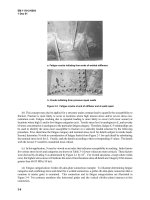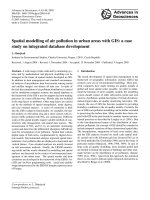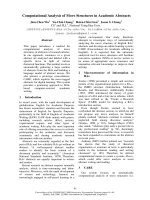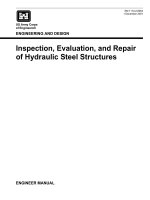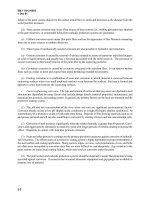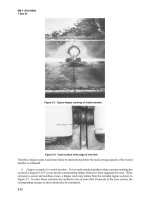Advanced modelling of steel structures in fire
Bạn đang xem bản rút gọn của tài liệu. Xem và tải ngay bản đầy đủ của tài liệu tại đây (1.7 MB, 155 trang )
ADVANCED MODELLING OF STEEL STRUCTURES
IN FIRE
BY
MA KAIYING
B.Eng. (Hons.), NUS
A THESIS SUBMITTED
FOR THE DEGREE OF MASTER OF ENGINEERING
DEPARTMENT OF CIVIL ENGINEERING
NATIONAL UNIVERSITY OF SINGAPORE
2003
i
Founded 1905
Advanced Modelling of Steel Structures in Fire
ACKNOWLEDGEMENT
The author would like to express her sincere gratitude and appreciation to her
supervisor, Associate Professor J. Y. Richard Liew for his invaluable guidance
throughout the course of this research work and for giving her opportunities to broaden
her knowledge through various training courses and conferences.
The author is also greatly indebted to Dr. Tore Holmas for his everlasting
willingness to render assistance on the use of USFOS and FAHTS.
The author’s sincere thanks also go to Associate Professor Quek Ser Tong,
Professor N E Shanmugam, Professor Wang Chien Ming, and Associate Professor
Choo Yoo Sang for their encouragement and invaluable advice on various occasions.
Special thanks are due to her family and Mr. Bao Shudong for their constant
encouragement.
Finally the author wishes to thank her colleagues and friends for making her
study and life in National University of Singapore a memorable experience.
ii
Advanced Modelling of Steel Structures in Fire
TABLE OF CONTENTS
TITLE PAGE I
ACKNOWLEDGEMENT II
TABLE OF CONTENTS III
NOMENCLATURE VI
LIST OF FIGURES VIII
LIST OF TABLES XIII
SUMMARY XIV
SUMMARY XIV
CHAPTER 1: INTRODUCTION AND LITERATURE REVIEW 1
1.1 Motivation 1
1.2 Research Objectives And Scope 3
1.3 Overview Of Contents 4
1.4 Literature Review 5
CHAPTER 2: ANALYSIS METHODS 10
2.1 Introduction 10
2.2 Simulation Of Natural Fire 10
2.3 Simulation Of Heat Transfer 10
2.4 Simulation Of Structural Response 13
CHAPTER 3: SIMULATION OF NATURAL FIRES 19
3.1 Eurocode Parametric Fires 19
iii
Advanced Modelling of Steel Structures in Fire
3.2 Heating Phase 20
3.2.1 Duration Of Heating Phase 20
3.2.2 Fuel-Controlled Fire 21
3.3 Cooling Phase 22
3.4 Multiple Layers Of Materials 22
3.5 Different Material In Walls, Ceiling And Floor 23
3.6 Effect Of Active Fire Fighting Measures On Fire Load Density 23
3.7 Example 24
3.7.1 Constant Fire Load Density With Different Opening Factors 25
3.7.2 Constant Opening Factor With Different Fire Load Densities 25
3.7.3 Effect Of Active Fire Fighting Measures 25
CHAPTER 4: VERIFICATION STUDIES 29
4.1 Numerical Analysis Assumptions 29
4.1.1 Coefficient Of Convection And Emissivity 29
4.1.2 Mechanical Properties Of Steel At Elevated Temperatures 32
4.1.3 Thermal Properties Of Steel 35
4.2 Verification Study I: Uniformly Heated Unprotected Steel Members 36
4.3 Verification Study II: Uk Standard Fire Tests On Three-Side Heated
Unprotected Steel Members
36
4.3.1 Numerical Modelling 36
4.3.2 Results & Discussion 37
4.4 Verification Study III Members With Passive Fire Protection 38
4.4.1 Spray-Applied Fire Protection 39
4.4.2 Board Type Fire Protection 40
4.5 Verification Study IV: Two-Dimensional Frames 40
4.6 Verification Study V: Three-Dimensional Frame 41
4.7 Conclusions 42
iv
Advanced Modelling of Steel Structures in Fire
CHAPTER 5: STUDY ON A SIX-STOREY BUILDING FRAME 67
5.1 Objectives Of Study 67
5.2 Description Of Frame And Loading 67
5.3 Ultimate Limit State Design 68
5.4 Fire Limit State Design 69
5.5 Fire Simulation 70
5.6 Fire Scenarios, Results And Discussions 71
5.6.1 Fire Occurs At The First Story 71
5.6.2 Fire Occurs At The Fourth Story 82
5.7 Results From Conventional Fire Resistance Design 83
5.8 Conclusions 84
CHAPTER 6: CONCLUSIONS AND RECOMMENDATIONS 118
6.1 Summary & Conclusions 118
6.2 Recommendations For Future Research 120
REFERENCE 122
APPENDIX A: NATURAL FIRE DERIVATION FLOWCHART 127
APPENDIX B: FIRE PROTECTION DESIGN EXAMPLE 128
APPENDIX C: EXAMPLE OF COMPUTER INPUT FOR 6-STORY FRAME
131
v
Advanced Modelling of Steel Structures in Fire
NOMENCLATURE
t
A
total area of enclosure including openings,
2
m
v
A
total area of vertical openings on all walls,
2
m
b
thermal inertia =
λρc , Ksm/J
2/12
c
specific heat,
kgK/J
h
convective heat transfer coefficient,
Km/W
2
eq
h
weighted average of window heights on all walls, m
k adjusting factor for fuel-controlled fire and large openings
m combustion factor
O
opening factor, =
teqv
A/hA,
1/2
m
lim
O
limiting opening factor,
1/2
m
d,t
q
design fire load density per total area,
2
MJ/m
d,f
q
design fire load density per floor area,
2
MJ/m
k,f
q
characteristic fire load density per floor area,
2
MJ/m
s thickness of surrounding material of compartment, m
t time, hour
t* fictitious time, hour
lim
t
limiting time for different fire growth rate, minute
T temperature, K
s
T
steel temperature, K
g
T
environmental gas temperature, K
b
Z
size of the bounding surface in two-surface plasticity model
vi
Advanced Modelling of Steel Structures in Fire
y
Z
size of the initial yield surface in two-surface plasticity model
m
α
absorption coefficient of steel surface
m
ε
emissivity coefficient of steel surface
f
ε
emissivity coefficient of flame
r
ε resultant emissivity =
mf
ε
ε
qi
γ
partial factor for fire activation risk
ni
γ
partial factor for different active fire fighting measures
c
γ
partial factor for heat transfer by convection
r
γ
partial factor for heat transfer by radiation
c,net
h
•
net heat flux by convection,
2
m/W
r,net
h
•
net heat flux by radiation,
2
m/W
σ
Stefan-Boltzmann’s constant =
,
8
1067.5
−
×
42
Km/W
ρ
density,
3
m/kg
λ
thermal conductivity,
mK/W
Γ
fictitious time factor
vii
Advanced Modelling of Steel Structures in Fire
LIST OF FIGURES
Figure 1.1 ISO-834 fire and natural fire (Schleich et al., 1993) 9
Figure 2.1 Re-meshing of line element to surface element for heat transfer analysis 16
Figure 2.2 Equivalent incremental temperature in FAHTS 16
Figure 2.3 Twelve-DOF beam-column element with force and displacement
components
17
Figure 2.4 Conventional Engineering Strain vs. nonlinear Green Strain 17
Figure 2.5 Contraction of initial yield surface and bounding surface at elevated
temperature
18
Figure 3.1 Rate of temperature decay in Eurocode parametric fires 26
Figure 3.2 Parametric fire curves for different surrounding materials 26
Figure 3.3 Parametric fire curves for different fire load densities 27
Figure 3.4 Parametric fire curves for different opening factors 27
Figure 3.5 Fire curves with and without active fire fighting measures 28
Figure 4.1 Measured creep strain at different stress and temperature levels. Reinforcing
steel 0.2% proof stress f
20ºC
= 710 Mpa, Anderberg (1988) 46
Figure 4.2 Predicted ultimate strength versus temperature: steady state, stress-rate
controlled, Anderberg (1988)
46
Figure 4.3 Predicted ultimate strength versus temperature: steady state, strain-rate-
controlled, Anderberg (1988)
47
Figure 4.4 Predicted ultimate strength versus temperature: transient state, Anderberg
(1988)
47
Figure 4.5 Stress-stain diagrams of steel at elevated temperatures, showing the
effective yield stress levels of steel, Twilt (1988)
48
Figure 4.6 Reduction of strength of steel at elevated temperatures 48
viii
Advanced Modelling of Steel Structures in Fire
Figure 4.7 Degradation of elastic modulus of steel at elevated temperatures 49
Figure 4.8 Relative size of yielding an bounding surface for design according to
Eurocode 3 (Skallerud and Amdahl, 2002)
49
Figure 4.9 Thermal elongation of steel as a function of the temperature 50
Figure 4.10 Specific heat of steel as a function of temperature 50
Figure 4.11 Thermal conductivity of steel as a function of temperature 51
Figure 4.12 Analysis and test results for 19 tests from Wainman (1988) 57
Figure 4.13 Measured thermal conductivity (Bardell, 1983) 58
Figure 4.14 Measured specific heat (Bardell, 1983) 58
Figure 4.15 Analysis and test results for columns protected with sprayed fibre 59
Figure 4.16 Analysis and test results for columns protected with cementitious coating
59
Figure 4.17 Details of column encasement (Konicek and Lie, 1973) 60
Figure 4.18 Predicted and measured steel temperature for 6 tests from Konicek and
Lie (1973)
63
Figure 4.19 Configuration of Li’s frame (1997) 63
Figure 4.20 Predicted and measured horizontal displacements at Node A and B (Tang,
2001)
64
Figure 4.21 Configuration of Zhao’s frame (1995) 64
Figure 4.22 Average temperature increase at mid-height of the left heated column
(Tang, 2001)
65
Figure 4.23 Predicted and measured displacements at Node C and D (Tang , 2001) 65
Figure 4.24 Computer model of 3-D test frame (Skallerud and Amdahl, 2002) 66
Figure 5.1 Layout of six-story frame 89
ix
Advanced Modelling of Steel Structures in Fire
Figure 5.2 Deformed shape of six-storey space frame at ultimate limit load at ambient
temperature
90
Figure 5.3 Load-displacement curve of six-story space frame 91
Figure 5.4 Fire curves for six-story frame without active fire control 91
Figure 5.5 Fire curves for six-story frame with active fire control 92
Figure 5.6 Fire compartments of six-story frame 92
Figure 5.7 Temperature development with time in columns 93
Figure 5.8 Temperature development with time in beams 7 and 9 93
Figure 5.9 Temperature development with time in beam 11 94
Figure 5.10 Temperature development with time in beam 12 94
Figure 5.11 Deformed shape of the frame under different load combination
(compartment 1)
95
Figure 5.12 Axial force in the four columns under load combination 1 95
Figure 5.13 Axial force in the four columns under load combination 2 95
Figure 5.14 Bending moment in the four columns as a function of temperature 97
Figure 5.15 Response of six-storey frame subjected to natural fire 102
Figure 5.16 Columns 1 and 2 head displacements under load combination 2 103
Figure 5.17 Columns 4 and 5 head displacements under load combination 2 103
Figure 5.18 Beam 7 mid-span deflections under load combination 1 104
Figure 5.19 Beam 9 mid-span deflections under load combination 1 104
Figure 5.20 Beams 7 and 9 axial forces under load combination 1 105
Figure 5.21 Beams 11 and 12 axial forces under load combination 1 105
Figure 5.22 Beam 11 mid-span deflections under load combination 1 106
x
Advanced Modelling of Steel Structures in Fire
Figure 5.23 Beam 12 mid-span deflections under load combination 1 106
Figure 5.24 Column 1 head displacements under load combination 1 107
Figure 5.25 Column 2 head displacements under load combination 1 107
Figure 5.26 Column 4 head displacements under load combination 1 108
Figure 5.27 Column 5 head displacements under load combination 1 108
Figure 5.28 Columns 1 and 2 head bending moments under load combination 1 109
Figure 5.29 Columns 4 and 5 head bending moments under load combination 1 109
Figure 5.30 Beam 9 mid-span and ends major axis moments 110
Figure 5.31 Beam 12 mid-span and ends major axis moments 110
Figure 5.32 6-story frame with modelling of floor slabs 111
Figure 5.33 Beams 9 and 11 mid-span vertical deflections and column 4 head
displacements under load combination 1 with modelling of slabs
111
Figure 5.34 Beams 9 and 11 axial forces under load combination 1 with modelling of
slabs
112
Figure 5.35 Beams 9 and 11 mid-span moments under load combination 1 with
modelling of slabs
112
Figure 5.36 Column 4 head moments under load combination 1 with modelling of
slabs
113
Figure 5.37 Beams 9 and 11 mid-span vertical deflections and column 4 head
displacements under load combination 2 with modelling of slabs
113
Figure 5.38 Beams 9 and 11 axial forces under load combination 2 with modelling of
slabs
114
Figure 5.39 Beams 9 and 11 mid-span moments under load combination 2 with
modelling of slabs
114
Figure 5.40 Column 4 head moments under load combination 2 with modelling of
slabs
115
Figure 5.41 Crack angle of the passive fire protection 115
xi
Advanced Modelling of Steel Structures in Fire
Figure 5.42 Columns temperature with and without passive fire protection 116
Figure 5.43 Deformed shapes of the frame under different load combinations
(compartment 2)
116
Figure 5.44 Plastic hinge formation sequence under load combination 1 when all four
columns are protected and all beams are unprotected (compartment 2)
117
xii
Advanced Modelling of Steel Structures in Fire
LIST OF TABLES
Table 4.1 Critical temperature of uniformly heated members 44
Table 4.2 Critical time and temperature of UK standard fire tests 44
Table 4.3 Test program of protected columns (Koniced and Lie, 1973) 45
Table 5.1 Member cross section dimension of the six-story frame 88
Table 5.2 Predicted failure times of the frame under natural fires using advanced
analysis (protected members are assumed to be remained at ambient
temperature)
88
Table 5.3 Required fire protection thickness by advanced analysis and conventional
design approach (sprayed mineral fibre, thermal conductivity
p
λ =
0.12
mK/W ) 88
xiii
Advanced Modelling of Steel Structures in Fire
SUMMARY
When a complete structure, as opposed to an isolated structural element, is
exposed to an attacking fire, there are a variety of interactions between structural
components. Because of these interactions, the behaviour of a steel structure in fire can
be drastically different from that of its structural elements in isolation. However, these
structural interactions cannot be accounted for in the current prescriptive approach of
fire resistance design which is based on fire tests of isolated members subjected to an
artificial fire. This research work presents an advanced modelling technique that can be
applied to assess the behaviour of a complete frame exposed to compartment fire by
establishing a direct relationship between the heating time and the fire resistance of the
structure in terms of strength and stability.
The research work presented in this thesis is an extension of the study by Tang
(2001). Both researches focus on the use of second-order refined plastic hinge analysis
to capture both material and geometric nonlinear effects of the structure exposed to
fire. Natural fire, in contrast to the artificial ISO standard fire, is simulated to represent
the real fire development in a building compartment. The underlying assumptions in
the analysis method are examined. Verification studies are carried out on both
components and frames over a wide range of parameters including uniformly heated
members, three-side heated members, members with passive fire protection, two-
dimensional frames as well as three-dimensional frames. The proposed approach is
then used to study the behaviour of a three-dimensional multi-story frame subjected to
natural compartment fires and to investigate the passive fire protection requirement for
the frame. The advantage of the advanced analysis over the conventional design
approach is highlighted.
xiv
CHAPTER 1
INTRODUCTION AND LITERATURE REVIEW
1.1 MOTIVATION
Structural steel has been widely used by architects and engineers for its
lightweight, fast-to-erect and aesthetic appealing characteristics. Under current design
philosophy, steel loses its strength and stability considerably at elevated temperatures,
requiring fire insulation to keep its temperature low. Currently, the fire resistance
design in most countries is still based on prescriptive codes derived from standard fire
tests of isolated members. The actual behaviour of the building in fire is not considered
in such an approach.
The prescribed codified approach suffers from a number of drawbacks. First of
all, the standard ISO fire curve (CEN, 2001a) has a continuously increasing
temperature rising at a decreasing rate. It does not represent real fires, which generally
consist of three distinct phases: a pre-flashover phase, a fully developed phase and a
cooling phase (Figure 1.1). Depending upon the building layout, the ventilation and the
amount of combustible materials, real fires could be less or more severe than the
standard fire.
The problem of achieving furnace harmonization is another drawback to the
standard fire test. Although the relevant test codes specify the same control
temperature, the heat flux experienced by the test specimen is dependent on the form
of construction of the furnace, the location of the burners relative to the specimen and
the type of fuel used.
In addition to the problems associated with the difference between the standard
fire and real fires, a number of difficulties arise in extrapolating the results from
1
Chapter 1 Introduction and Literature Review
standard fire tests to structural performance in a real building.
Firstly, due to the high cost of the standard fire test, it is not feasible to conduct
tests to address every conceivable section size and length, end condition and loading
condition. The geometric limitations of specimen size also mean that it is not possible
to simulate complicated three-dimensional structural behaviour.
Secondly, no allowance can be made for the beneficial or detrimental influence
of restraint provided by the surrounding structure during the test. Because of
interactions between structural components, the behaviour of a steel structure in fire
can be drastically different from that of its structural elements in isolation. Alternative
load carrying mechanisms or modes of failure are not accounted for in the test.
Thirdly, the present prescriptive codes are limited to the type of structure where
the influence of global instability is small. They may not be applicable for complex
and flexible structures.
It has been recognized by practitioners that strict adherence to the current
prescriptive rules can lead to an uneconomic and inflexible design, making
constructional steel not competitive against concrete or other building materials. With
the advance in computing technologies, the adoption of a rational, performance-based
approach over conventional prescriptive approach thus becomes more compelling to
allow architects and engineers greater freedom to design structures economically,
without compromising the required level of safety.
In this research, an integrated fire analysis is proposed for the design of steel
structures in natural compartment fires. Realistic fires are considered instead of the
ISO standard fire. The mechanical response is simulated using a robust and efficient
second-order plastic-hinge approach, which requires only one line element per physical
member of the structure to obtain a realistic representation of the global non-linear
2
Chapter 1 Introduction and Literature Review
effects of the structure.
1.2 RESEARCH OBJECTIVES AND SCOPE
The main objectives of the present research are (1) to validate the accuracy of the
proposed analysis methods against experimental results and (2) to fill in the gaps in
existing knowledge of the overall structural behaviour of steel frames subjected to
natural fires, and (3) to highlight the advantages of the use of advanced analysis for
economical and safe fire resistance design. In particular, the following studies are
carried out to meet the objectives:
- The investigation of the effect of ventilation, fire load and active fire
suppression system on the development of fire in the compartment;
- The validation of the use of advanced analysis through verification studies on
individual members, two-dimensional frames and three-dimensional frames;
- The assessment of the fire resistance of multi-storey steel frames considering
realistic fires and the behaviour of the frame as a whole.
In this research, the modelling of natural fire is based on Eurocode prEN 1991-1-
2 (CEN, 2001a) considering possible active fire fighting measures. The analysis
focuses on the assessment of fire resistance and damage of structures under post-
flashover compartment fires. Transient heat transfer analysis using FAHTS (Holmas,
1995) and second-order refined plastic hinge analysis using USFOS (Soreide, et al.,
1994) are performed to study the behaviour of unprotected and protected multi-storey
buildings under different compartment fire scenarios. The advantage of the advanced
analysis method over conventional prescriptive approach in providing a more realistic
assessment of structural performance in fire is highlighted. The present work is limited
to steel structures, taking into consideration the heat-sink effect of concrete slab on the
top of the steel beam without composite action between the slab and the steel beam.
3
Chapter 1 Introduction and Literature Review
1.3 OVERVIEW OF CONTENTS
Chapter 1 provides an overview of the current problems and defines the
objectives and scope of the present investigation. A brief literature review on the fire
tests carried out around the world and the development of the fire resistance design
method is given.
Analysis methods used in the research are summarized in Chapter 2, followed by
a brief description on the heat transfer analysis program FAHTS (Holmas, 1995) and
structural analysis program USFOS (Soreide, et al., 1994).
In Chapter 3, the formulation of natural fire curves according to Eurocode prEN
1991-1-2 (CEN, 2001a) is presented. The effect of several fundamental parameters
such as fire load, ventilation and properties of surrounding surfaces on the fire
development is studied with consideration of possible active fire suppression systems.
Examples of natural fire curves under different scenarios are given.
Extensive verification studies are carried out over a wide range of parameters
including uniformly heated members, three-side heated members, members with
passive fire protection, two-dimensional frames as well as three-dimensional frames.
The description of each study and the results are summarized in Chapter 4. Underlying
assumptions in the analysis such as the mechanical and thermal properties of steel at
elevated temperature are presented. The effect of coefficient of convection and
emissivity on the steel temperature development is discussed.
After the use of the advanced analysis method is successfully validated, in
Chapter 5, the proposed method is applied to investigate the behaviour of a three-
dimensional six-storey unbraced frame subjected to various fire scenarios. The
computed results are compared to those from the conventional approach based on the
ISO standard fire curve and the advantage of the advanced analysis is demonstrated.
4
Chapter 1 Introduction and Literature Review
The design implications on the requirement of passive fire protection are also
discussed.
Chapter 6 concludes with a summary of the findings. The limitations of the
proposed method and directions for further research are also indicated.
1.4 LITERATURE REVIEW
The demand for more competitive steel construction and a desire to pursue a
better understanding of the structural behaviour in fire have stimulated intensive
activities and research works in recent years. Experiments are carried out and
predictive methods are developed to simulate the behaviour of structures in fire.
Though expensive and time consuming, fire tests have offered researchers and
engineers an insight into the behaviour of structural members and frames in fire. A
summary of fire tests carried out around the world can be found in Wang (2002). The
standard fire tests on isolated members carried out in the UK (Wainman and Kirby,
1988) provide a valuable database for the development of accurate calculation
methods. Different types of member were tested including floor beams exposed to fire
on three sides with different restraint condition, simply supported shelf angle floor
beams, simply supported slim floor beams, columns exposed on four sides, columns
with blocked-in webs and columns in walls. Results of eighteen tests on simply
supported floor beams supporting concrete slab without composite action between the
steel and the slab are used in this research to validate the accuracy of the proposed
method. Konicek and Lie (1973) and Bardell (1983) performed fire tests on protected
steel columns insulated by different types of materials. Their studies are simulated to
validate the heat transfer analysis with the presence of passive fire protection.
In China, fire experiments were carried out on two-dimensional skeletal steel
frames in Tongji University (Zhao, 1995 and Li et al., 1997). Tang (2001) simulated
5
Chapter 1 Introduction and Literature Review
two of the tests using the proposed method and good agreement was found between the
analysis and the test data. The three-dimensional steel frame test conducted in
SINTEF, Norway (Skallerud and Amdahl, 2002) has also shown excellent correlation
between the simulations using the proposed method and the test results.
Researchers also carried out tests (Kirby and Preston, 1988 and Outinen et al.,
2001) to investigate the mechanical properties and stress-strain relationships of steel at
elevated temperatures and to address the implications of material model on steel
behaviour (Twilt, 1988; Anderberg, 1998 and Cooke, 1998), details of which are
discussed in Chapter 4.
Among all the experiments on frames, the largest and the most influential one is
the full-scale fire tests on an eight-storey steel-framed building at Cardington (Kirby,
1996 and Bailey et al., 1999). A total of six major fire tests were conducted: restrained
beam test, plane frame test, two corner compartment tests, one large compartment test
and one large compartment with furniture test. These tests have produced a huge
amount of experimental data that are valuable for validation of computer modelling
and understanding of the physical phenomena that dominate complete structural
behaviour under fire.
Sophisticated analytical methods have been developed to simulate and
supplement the fire tests. The results from experiments and analysis (Bailey et al.,
1996 and Gillie et al., 2002) confirm that existing fire codes are not addressing the
correct building behaviour during a fire and, as a consequence, are extremely
conservative. In contrast to the common view that the behaviour of composite structure
is governed by the effects of strength loss caused by thermal degradation, and the large
runaway deflections that result from the imposed loading on the weakened structure,
the experiments reveal that it is the thermally induced forces and displacements that
6
Chapter 1 Introduction and Literature Review
dominate the response of highly redundant structures under local fires. At extreme
temperatures when deflections become large, an alternative load carrying mechanism,
mobilising tensile action in the reinforcement mesh and the continuity of the slab
system, provides robust redistribution paths to maintain structural stability by tensile
membrane action.
Fire tests are limited in number and scale because of the high cost involved.
Accurate analytical and numerical methods are thus necessary to predict the fire
resistance of members and frames. Researchers have proposed a number of approaches
including the elementary mechanics approach (Pettersson et al., 1976), the plastic
method (Wong, 2001), the Rankine approach (Toh et al., 2001), the secant-stiffness
method (Burgess et al., 1991), the plastic hinge-based method (Liew et al., 1998; Chan
and Chan, 2001), and the finite element approach (Anderberg, 1988; Saab and
Nethercot, 1991; Wang et al., 1995; El-Rimawi et al., 1995; Huang et al., 2000).
The first three methods are simplified approaches and are only suitable for
members and simple frames. Pettersson et al. (1976) describe a deflection analysis of a
simple frame using algebraic equations. The principal change in applying the same
algebraic equations from ambient temperature structural calculations to fire resistance
evaluations is by adjusting the material mechanical property values to reflect their
dependence on temperature. Wong’s approach (2001) is based on the plastic hinge
concept using both the elastoplastic method and the upper-bound method, which is
established on assumed collapse mechanisms. Geometric nonlinearity, local and global
bucking are not included. Toh et al. (2001) extends the classical Rankine formula to
take into account material degradations at elevated temperatures. The strength and
stability of the structures are evaluated using rigid-plastic and elastic buckling
analyses.
7
Chapter 1 Introduction and Literature Review
The secant-stiffness method proposed by Burgess et al. (1991) is formulated
according to the moment-curvature relationships of steel cross-sections using stress-
strain relations at different temperature. The method accounts for the shift of neutral
axis and the additional deformation due to non-uniform heating. It is suitable for
analysis of flexural members and structures.
Finite element approach is versatile and can adequately model the behaviour of
any structure, but it requires laborious and highly skilled modelling techniques with
high computational cost. Because of this, most of the researches carried out so far
using finite element method are focusing on the behaviour of a particular structural
component, for example connections, beams and columns, slabs, or two-dimensional
frames or sub-frames of three-dimensional structures. It is rarely cost-effective to use
finite element method to study the behaviour of complicated three-dimensional frames.
Plastic hinge-based approach, on the other hand, has demonstrated its robustness and
efficiency in analysing such structures with reasonable accuracy. Examples are
illustrated in detail in Chapter 4. The two methods can be complementary to each other
to study the local and global behaviour of a complete structure. However, from a
practical design point of view, the plastic hinge-based approach is more feasible and
efficient with adequate level of safety.
8
Chapter 1 Introduction and Literature Review
Gas Temperature
Flashover
Cooling Phase
Active Fire Protection
- detection
- extinction
- ventilation
Passive Fire
Protection
ISO-834
Pre-Flashover Phase
Failure of active
measures
Success of active measures
Fully Developed Fire
Time
(
min
)
Figure 1.1 ISO-834 fire and natural fire (Schleich et al., 1993)
9
CHAPTER 2
ANALYSIS METHODS
2.1 INTRODUCTION
The analytical assessment of fire resistance of structures using the proposed
method of this thesis includes three principal aspects: (1) simulation of the fire in the
compartment; (2) transient heat transfer analysis to calculate temperature development
of steel members with time; and (3) structural analysis to determine the failure time
and temperature of the structure considering various thermal effects and loading
combinations.
2.2 SIMULATION OF NATURAL FIRE
The simulation of natural fires is according to the parametric temperature-time
curve in Eurocode prEN 1991-1-2 (CEN, 2001a). It provides a simplified but
reasonable way to derive the parametric compartment fire curves based on several
fundamental parameters such as fire load, ventilation and properties of the surrounding
enclosure surfaces. The details of derivation and the effect of various parameters on
the development of fire in the compartment are presented in Chapter 3.
2.3 SIMULATION OF HEAT TRANSFER
The structural analysis software USFOS (Ultimate Strength of Framed Offshore
Structures, Soreide, et al., 1994) is based on plastic-hinge concept using beam-column
element. However in order to capture the temperature variation along the member
length and across the member cross-section, the beam-column element is subdivided
into quadrilateral finite elements in heat transfer analysis using FAHTS (
Fire And
Heat Transfer Simulations, Holmas, 1995) as shown in Figure 2.1. Heat conduction,
convection and exchanges of radiation are calculated on the basis of these finite
10
Chapter 2 Analysis Methods
elements according to two-dimensional heat transfer in Equation (2.1) assuming
uniform temperature across the thickness of an element.
q)
y
T
(
y
)
x
T
(
yt
T
c
yx
+
∂
∂
λ
∂
∂
+
∂
∂
λ
∂
∂
=
∂
∂
ρ (2.1)
where T and t are the steel temperature and time respectively.
ρ
and c are mass density
(
) and heat capacity ( ).
3
m/kg kgK/J
x
λ
and
y
λ
are the thermal conductivity
in local x and y directions of the finite element. )mK/W(
q
is the heat input
to the system. This equation is a standard heat transfer equation, which
means the rate of increase of heat in a particular volume V is equal to the rate of heat
conduction into the volume V plus the rate of heat generation within V.
)m/W(
3
The transient temperature field problem is discretized in the space domain
resulting in a set of linear ordinary differential equations for each element. The
integration over the total space domain is obtained by summation over all elements
which can be expressed as:
)T(QT)T(KT)T(M
iiiii
=+
&
(2.2)
where M is the mass matrix including heat capacity at time step
i; K is the thermal
conductivity matrix at time step i and Q is the nodal consistent heat vector at time step
i, all as a function of temperature
. The consistent nodal heat flux vector Q is the
vector of total nodal point heat flow and can be expressed as:
i
T
∑
∫
=
j
S
jS
ST
Si
j
jj
dSNqN)T(Q (2.3)
where subscript j denotes element no. j; q
S
is the rate of heat transfer (by convection
and radiation) per unit surface area S
j
and N
Sj
is the vector of interpolation functions
11
